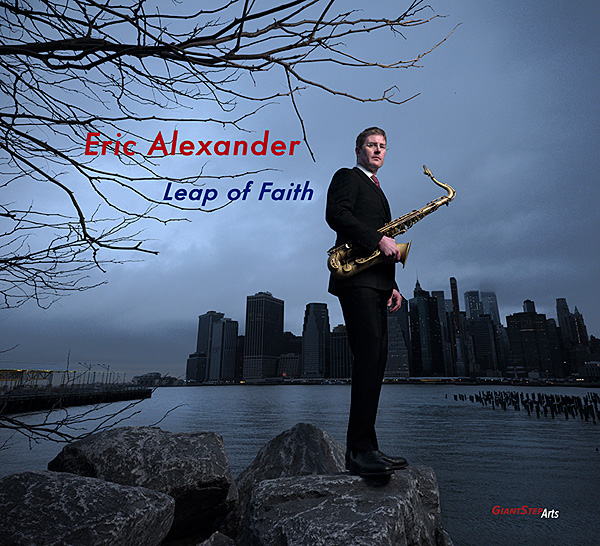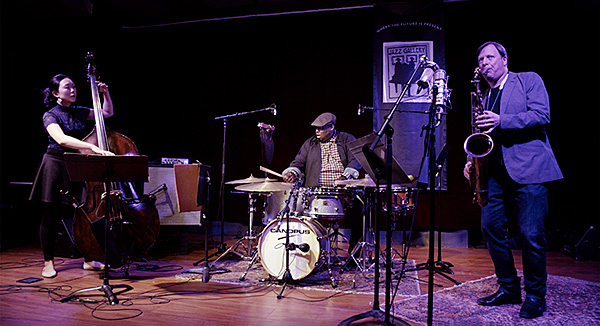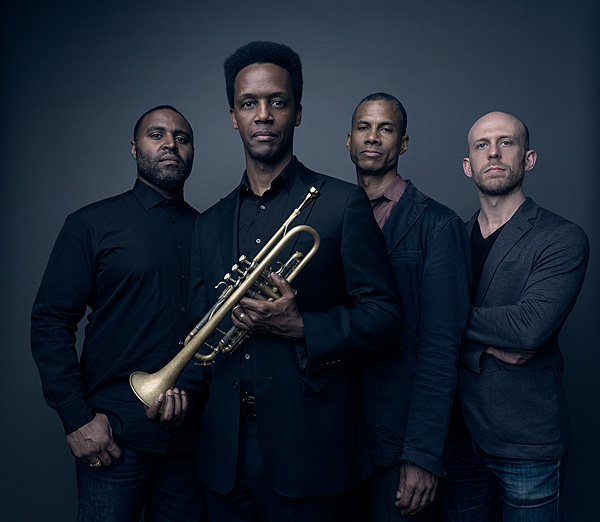| Columns Retired Columns & Blogs |
Bought all three!
Thanks for a great article!

Leap of Faith is a wild ride, and what it rides on is the seething, complex energy of Blake, a remarkable talent. It would be difficult to overstate Blake's influence on the passion of this album.
Alexander has said that he "just let things fly." Yet Leap of Faith is the most accessible of the GSA releases to date. Alexander was aware that chord-less ensembles present challenges for listeners, adding "when there is no harmonic reference instrument, the horn player needs to be demonstrative and specific with the harmony." He is an artist who, even in extremis, gravitates toward coherence.
Sonically, these three records are stunning. All were recorded at live gigs in 2018 at the Jazz Gallery, at 1160 Broadway in Manhattan. Very few jazz recordings made in clubs or concert halls have ever achieved the detail, clarity, and balance of these three albums. For that matter, not many studio recordings are this accurate. More important, their resolution is achieved while capturing the visceral excitement that happens only when a jazz band burns before a live audience, creating music in the electric moment that will never be repeated.
When you speak at length to Katz, you understand that he is a special combination of aspirational idealism and no-bullshit realism. The idealism is reflected in his lofty ambitions for the music that comes out of the GSA project: "My background is photography. A great photograph overwhelms. Seeing it changes you. It is not just 'nice.' Hearing great jazz changes you. I once heard Sonny Rollins in his prime, just warming up. My jaw hit the floor. The first time I heard McCoy Tyner, he struck one chord, and it was like the heavens opened up, like a thunderbolt from God. I am not interested in putting out some nice jazz records. I work with artists who are ready to make large, bold artistic statements. I expect them to try to make a masterpiece. That puts a lot of pressure on them. But I work with the greatest musicians now playing jazz. When I approach musicians, I ask them, 'What would be your dream ensemble? Who are the people who will help you make your best artistic statement?' That's how we end up with people like Chris Potter and Mark Turner and Linda Oh in our bands. That's why one of our leaders, Johnathan Blake, also appears as a sideman."

The realism is reflected in Katz's attitude toward the recording process. He describes the three GSA releases to date as compromises. "The biggest problem with remote recording is that most of the places where jazz is played don't really sound that good. The Jazz Gallery is a very live, boomy room. But my priority is always the performance. History is going to remember a great performance, regardless of the sound. When you ask musicians where they play best, most will say in a live situation."
The Jazz Gallery is not a club but a 1500-square-foot, fifth-floor loft. Like GSA, it is a 501(c)(3) nonprofit. It provides residencies, mentoring programs, and rehearsal spaces for musicians. Three nights a week, 50 weeks a year, it becomes a dark, funky jazz joint. "Musicians love the vibe, so I record there," Katz says. "But it is a space where you have to be very precise with the placement of microphones. You have to really know your microphones. And I explain to musicians that they need to be very conscious of playing in balance. You can't have a drummer bashing away, drowning everyone out. I work mostly with virtuosos. They get it."
Katz describes his typical microphone setup for a band like Palmer's quartet: "I put spot mikes on the instruments: probably five on the drums, three on the bass, one each on the trumpet and tenor. Then I put a stereo pair, about eight inches apart, in front of the band. How far back depends on the room. I use Flea microphones, from Slovakia. They are Neumann clones. I love the Flea 47 on saxophones. I use a ribbon mike made in the United States, the AEA R44C. It is a replica of an RCA mike from the '30s. I use it for trumpets. These are studio-grade mikes. Many engineers are reluctant to use them for on-site jazz recordings. They are expensive, and they might get knocked over or get beer spilled on them. But I take the risk because the most important element in the signal path is the microphone. I record on three Sound Devices 788Ts, synced for 24 tracks, but my dream is to upgrade to their new Scorpio. For monitoring, I love Etymotic ER-4SR earphones, which is also one of my references when mixing, along with Wilson [Audio Specialties] WATTs."

But if Katz accepts no compromises with equipment, he describes the process of creating a GSA album as one of cooperation and accommodation. "My approach has changed somewhat over the years. Now when I mix, I rely more on the spot microphones and less on the stereo pair. The stereo pair gets the overall sound of the band and more of the room. But today, most musicians and most listeners want to hear a closer representation of the event. When musicians play, they are very close to their instruments and to each other. When they listen to a recording, they would rather get a sense of that closeness. So they love spot mikes. GSA is very musician-oriented. If a leader says, 'This is my sound,' we take that into consideration when we mix the record, consistent with a certain level of quality. After all, it is the player's artistic statement, not mine. Plus, I am not trying to get a good saxophone sound. I am trying to get Eric Alexander's saxophone sound. These are artistic decisions. There's no right or wrong."
Katz also acknowledges other factors that affect the decision-making process. Recent trends originating in popular music create an expectation for more compression and more bass. The mix needs to work for different playback scenarios, such as laptops, car stereos, and earbuds. "My original plan for GSA was to make recordings solely for audiophiles. But we have to offer sound that a majority of people want to listen to," Katz said.
When you hear an earlier Katz recording, such as Noah Preminger's Pivot: Live at the 55 Bar, from 2015, you sense more of the 55 Bar, the room and the crowd. If the GSA recordings provide less of the live-moment illusion, it's a trade-off made in the name of "closeness." On the other hand, the reproduction of Palmer's trumpet is so alive it's scary. You experience the riveting brassy expletives, but you also perceive the nuances, hesitations, and shadings that come when brilliant notes begin with vulnerable human breath. And the three saxophone sounds are indeed particular and distinct. Potter's is searing. Turner's is darker. Alexander's is clarion, even when he rasps. Katz and Dave Darlington may have included laptops in their thinking, but there's absolutely no problem with the way these records sound through a high-end system. They sound marvelous. Audiophiles, after all, are not immune to the joys of closeness and powerful bass and dynamic intensity. When Johnathan Blake's drums knock you flat on your ass, it feels good.
Giant Step Arts, if it proves scalable, could become an important model for private support of America's only indigenous art form. Katz believes that in today's environment, jazz musicians "need to get more entrepreneurial." GSA does not sell anything. Instead, it encourages musicians to bring fresh ideas to marketing their art and equips them with tools for that effort. The music is currently offered online through artists' websites, CD Baby, and Bandcamp. Over time, these albums should become sought-after limited editions. They are extraordinary, not only musically and sonically but visually. Katz's photographs of artists, with the Manhattan skyline in the distance, are beautiful.
Katz has four recording sessions scheduled for the remainder of 2019, including a new Palmer quintet and a new Blake quartet. These projects are already funded, and the albums will appear in 2020. GSA's next funding year begins in September 2019. Katz believes that his donors—who are invited to gigs that get recorded, and to rehearsals and mixing and mastering sessions—will support the program for another year.
Jimmy Katz, famous photographer and respected engineer, has now added three more titles to his résumé: fundraiser, program manager, and record producer. Anyone who has produced a record has fantasized about making a "large, bold artistic statement." Katz has done it, three times. Giant Step Arts is news for that reason. There probably are more such statements to come.

This is where the Hi Fi rubber hits the audio road, fellow enthusiasts!
All fresh, not frozen and warmed up, again.

Fantastic concept and recordings! Any chance of them appearing on LP as well?